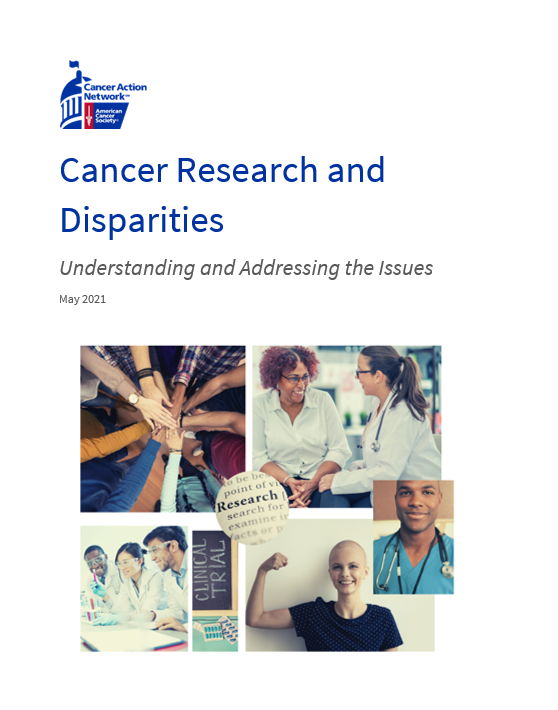The COVID-19 pandemic has made clear the significant disparities that exist in our health care system and the need to address their root causes, including in cancer care. Ensuring all individuals – regardless of age, race, ethnicity, socioeconomic status, education, sexual orientation, insurance status, or zip code – have the same opportunities to prevent, detect, and treat cancer requires understanding what role research plays in potentially causing disparities as well as how research can help identify and address the causes of disparities. While disparities have been described in various domains of cancer research, each issue exists separately and has a different relationship to understanding and addressing disparities in clinical outcomes. The various domains of research disparities are explored in the ACS CAN report Cancer Research and Disparities: Understanding and Addressing the Issues.
need to address their root causes, including in cancer care. Ensuring all individuals – regardless of age, race, ethnicity, socioeconomic status, education, sexual orientation, insurance status, or zip code – have the same opportunities to prevent, detect, and treat cancer requires understanding what role research plays in potentially causing disparities as well as how research can help identify and address the causes of disparities. While disparities have been described in various domains of cancer research, each issue exists separately and has a different relationship to understanding and addressing disparities in clinical outcomes. The various domains of research disparities are explored in the ACS CAN report Cancer Research and Disparities: Understanding and Addressing the Issues.
Key Report Findings
- Disparities in Cancer Clinical Trial Participation
- The makeup of cancer clinical trials does not represent the real-world population which limits the broader applicability of trial results, leading to social injustice. Racial and ethnic minority groups, older adults, rural residents, and those with lower socioeconomic status tend to be underrepresented in cancer clinical trials, despite an increased burden of disease and an equal willingness to participate in clinical research.
- Researching Disparities in Cancer Outcomes
- Certain groups bear a disproportionate burden of cancer. Cancer disparities research investigates outcome differences between groups and the underlying factors driving differences. Research to identify and address disparities in outcomes has to be deliberate and specifically designed. Conclusions from this research can inform evidence-based solutions for alleviating disparities.
- Cancer Workforce Disparities
- The cancer care and research workforce does not represent the U.S. population demographically. A diverse workforce can help to reduce implicit biases and systemic disparities; however structural barriers impede workforce diversity. As racial and ethnic minority groups in the U.S. grow and increasingly make up a larger share of the population, addressing cancer disparities in these groups can be enhanced by increasing diversity within the cancer care and research workforce.
 need to address their root causes, including in cancer care. Ensuring all individuals – regardless of age, race, ethnicity, socioeconomic status, education, sexual orientation, insurance status, or zip code – have the same opportunities to prevent, detect, and treat cancer requires understanding what role research plays in potentially causing disparities as well as how research can help identify and address the causes of disparities. While disparities have been described in various domains of cancer research, each issue exists separately and has a different relationship to understanding and addressing disparities in clinical outcomes. The various domains of research disparities are explored in the ACS CAN report Cancer Research and Disparities: Understanding and Addressing the Issues.
need to address their root causes, including in cancer care. Ensuring all individuals – regardless of age, race, ethnicity, socioeconomic status, education, sexual orientation, insurance status, or zip code – have the same opportunities to prevent, detect, and treat cancer requires understanding what role research plays in potentially causing disparities as well as how research can help identify and address the causes of disparities. While disparities have been described in various domains of cancer research, each issue exists separately and has a different relationship to understanding and addressing disparities in clinical outcomes. The various domains of research disparities are explored in the ACS CAN report Cancer Research and Disparities: Understanding and Addressing the Issues.